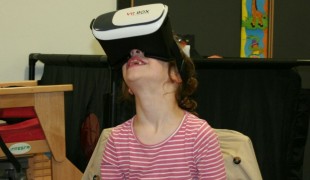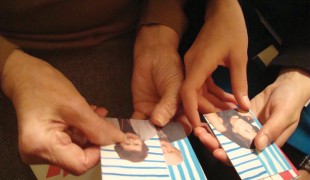- 3647
- 287
- 6
- 6
- 0
- Help Ukraine
About the solution
The musician used different technologies over the years to help him perform tasks such as composing songs, reading books, interacting with people, etc.
Gary, with his son’s help, developed simple way for his Jason to communicate using a hand-painted geometrical eye chart. The user spells by moving his eyes to the letters in the separate sections of the board, although at home, his family has learned to "read" his eye movements without the aid of the letter board. It’s faster and more efficient than having someone slowly call out all the letters from A-Z until Jason blinked.
"I still haven't found anything as quick and efficient as my dad's system," Jason stated.
The Becker System was designed to allow a beginner user to quickly become familiar with the layout of a simple eye-movement spelling system and begin communicating immediately.
The eye movement communication system Jason and Gary developed is uniquely theirs but does follow the principals of the E-Tran method (E-Tran is a standard, though thoroughly underused, low-tech Augmentative Alternative Communication method).
It works with only two eye-movements that are necessary to reach any given letter in the system. Complete eye-movement is required to use the system successfully. The patient first indicates which block the letter he wishes to spell is located in by moving his eyes in that direction: Upper, Left, Upper, Middle, Upper, Right, Lower. The caregiver or reader will have these directions in reverse, i.e. when the patient's eyes go to the upper left, it will appear as the caregiver’s upper right.
Despite his condition, Jason is still composing songs and releasing albums.
You can check the system’s instructions in the file attached.
More info: http://jasonbecker.com
Adapted from: http://bit.ly/2r0aLV6
https://youtu.be/AYSXh5sfLtY
这些解决方案不应包括使用药物,化学品或生物制品(包括食品);创伤性设备;冒犯性的,商业或内在危险的内容。该解决方案未经医学验证。请谨慎进行!如果您有任何疑问,请咨询健康专家。
DISCLAIMER: This story was written by someone who is not the author of the solution, therefore please be advised that, although it was written with the utmost respect for the innovation and the innovator, there can be some incorrect statements. If you find any errors please contact the patient Innovation team via info@patient-innovation.com
-
-
765
-
0
-
17104

Proloquo2Go – App to help people communicate
CAREGIVING
COMMUNICATION: Communicating, whether by speaking, listening, or other means
Social interaction
Paralysis
Autism
Cerebral Palsy
Brain Stroke
Brain Injury (Abscess, Brain Barrier Defect, Brain Contusion, Brain Hemorrhage, Brain Edema)
Assistive Daily Life Device (to help ADL)
Assistive Technology access
App (Including when connected with wearable)
Tremors
Muscle cramps or spasms
Difficulty coordinating movements
Muscle weakness
Difficulty speaking or understanding speech
Trouble with fine motor skills (e.g., writing, buttoning clothes)
Twitching or involuntary movements (myoclonus)
Acquired language impairment (Aphasia)
Promoting self-management
Managing Neurological Disorders
Building Supportive Community Relationships
Promoting inclusivity and social integration
Improving Speech and Communication
Caregiving Support
Clinical Pathology
Medical Genetics
Neurology
Pediatrics
Rheumatology
Netherlands
-
-
-
541
-
3
-
8266

Dad uses virtual reality to help his daughter who suffers from Williams Syndrome
COMMUNICATION: Communicating, whether by speaking, listening, or other means
Social interaction
foetal alcoholic syndrome
DiGeorge Syndrome
Angelman Syndrome
Neuromuscular Disorders
Assistive Technology access
App (Including when connected with wearable)
Difficulty coordinating movements
Difficulty speaking or understanding speech
Trouble with fine motor skills (e.g., writing, buttoning clothes)
Cognitive impairment
Memory loss
Anxiety
Sensitivity to light or sound
Depression or anxiety
Managing Neurological Disorders
Improving Speech and Communication
Caregiving Support
Medical Genetics
Neurology
Pediatrics
United Kingdom
-
-
-
720
-
0
-
11522

Communication design to help with Alzheimer’s
CAREGIVING
Social interaction
COMMUNICATION: Communicating, whether by speaking, listening, or other means
Alzheimer's Disease
Book/Comic
Educational/Leisure device (book, toy, game...)
Memory loss
Confusion
Sleep disturbances
Depression or anxiety
Managing Neurological Disorders
Promoting inclusivity and social integration
Enhancing Mental Health
Improving Speech and Communication
Caregiving Support
Neurology
Psychiatry
Portugal
-
 zh
zh